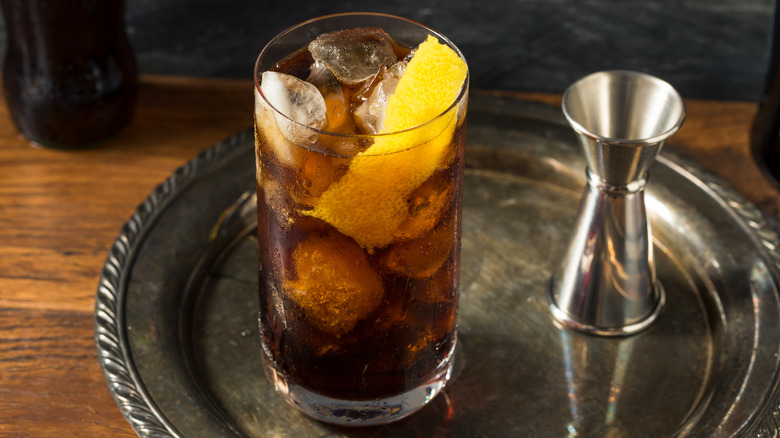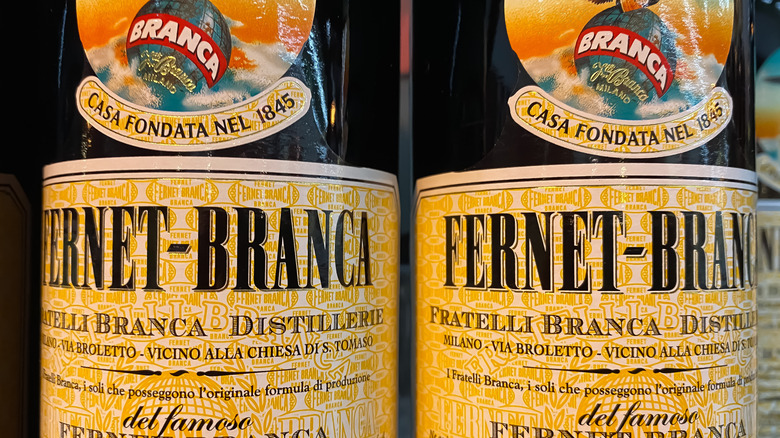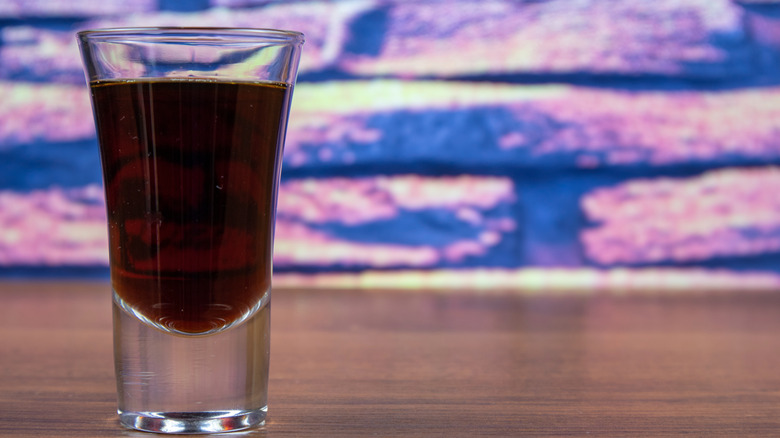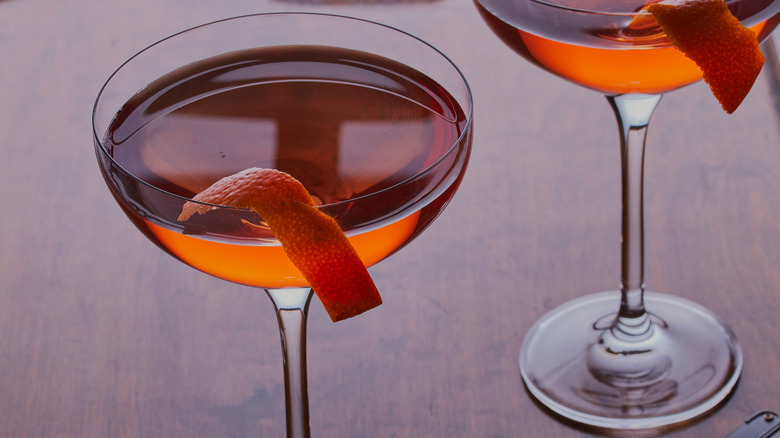What Is Fernet Liqueur And What Does It Taste Like?
As far as hip liqueurs go, Fernet just might rule the pack. This dark, medicinal tasting Italian liqueur has swept up the fancy, herbaceous craft cocktail scene Stateside in recent years with Tasting Table even going as far as to say it's taken "America by storm." In addition to commonly finding this beverage behind the bars of more and more US watering holes, craft distillers have also begun making their own versions of the licorice-like spirit for discerning consumers.
But what exactly is Fernet? The spirit (pronounced fer-net) is "classified as an Italian bitter," says Tasting Table. And the deep brown liqueur has a history –rooted in medicine (via Eater) — as rich as its flavor profile. According to both articles, the first Fernet originated in Italy in the 19th century, but the bitter drink has been evolving and growing in popularity ever since, with drinkers across the globe enjoying the unique spirit more and more nowadays, and for good reason.
The rich history of Fernet
The first bottle of Fernet was alleged to have been created for medicinal purposes by a physician of the same name, says Eater. Dr. Fernet's concoction, a mixture of more than "50 herbs and botanicals" (via Eater) was originally marketed as an aid for many ailments, from hangovers and digestion to cholera and impotence. But Dr. Fernet's recipe — if he's even real (Tasting Table claims it's one big myth) — didn't taste like the sip-able liquor we see today.
Instead, a man from Milan, Felice Vittone, doctored up the original clinical recipe in 1842 to make a more enjoyable, tasty version, which he called Fernet Vittone, says Eater. A couple of years later, Bernandino Branca (a part of Fratelli Branca Distillerie, also in Milan) created Fernet-Branca in 1845, according to The Manual. And even today, when it comes to titans of the Fernet world, Fernet-Branca is by far still the biggest brand name within the category. The brand is so prominent in fact, Fernet-Branca often gets confused as the name of the liqueur itself (think Band-Aids and Kleenex).
According to From The Grape Vine, Italians brought the beverage to Argentina in the 20th century, where it was just as popular as in Italy. In recent years, its draw has started to hit American soil as well.
This is what Fernet tastes like and how it's made
Even today, popular brands like Fernet-Branca maintain secrecy around their recipes. According to Eater, Fernet-Branca doesn't list all the herbs used to create the liqueur, but does disclose that there are 27 of them. The herbaceous, medicinal spirit can contain any number of herbs and spices, possibly including tree bark, orange peel, peppermint, cardamom, myrrh, aloe, and chamomile, says Tasting Table. Eater further notes that saffron is a prominent ingredient in the mix, claiming that Fernet-Branca is actually responsible for purchasing three-fourths of the world's supply.
According to From The Grape Vine, the base that serves as the backbone to all of Fernet's flavoring is often a grape distilled spirit. Rather than being distilled like many other liqueurs, Fernet instead uses the base spirit and "infuses it like a tincture with a special combination of botanicals," says Tasting Table. The article also notes that, in the case of Fernet-Branca, that brand is housed in oak barrels for a year to further bring out the flavors.
All these herbs and spices mixed together create a strong flavor profile with caramel coloring that further alludes to its richness. While From The Grape Vine describes the flavor as "licorice devoid of sugar," Tasting Table describes it as more of an "earthy mix of woodsy cologne, tea-tree oil, and unsweetened cough medicine." The Manual explains that, as a bitter liqueur, bitterness is of course at the forefront of the spirit's flavor profile but it's still very drinkable.
Fernet's ABV falls typically around 40%, notes Eater.
The best ways to drink Fernet
Even today, with Fernet firmly moved out of the doctor's office and into the bar, the liqueur is still often used as a digestive aid. Tasting Table explains that when sipped, Fernet "does a great job at settling the stomach," which is why it's often sipped after a meal as a digestif. Taking a round of chilled or room temp Fernet shots around closing time is persuasive among San Francisco bartenders, Tasting Table adds, sometimes accompanied by a side sip of ginger ale.
But, sipping it straight isn't the only way to enjoy this spirit. In South America, a simple mixture of Fernet and cola is a common way to enjoy the liqueur. A smidge of Fernet slipped into a coffee or espresso is also an option. There are also popular craft cocktails that include the bitter amaro like the Hanky Panky, notes Tasting Table, that originated in London in 1903. Savoy Hotel's bartender Ada Coleman created that Fernet-forward drink — a combination of sweet vermouth, gin, and Fernet, finished with an orange peel — which is now one of the most popular Fernet cocktails you can order.
Fernet varieties and where to find them
With its popularity Stateside having grown in the last few years, Fernet is not hard to find. Local liquor stores and bars are likely to at least carry the ever popular Fernet-Branca. But, when in doubt, check online to find what stores may be selling bottles near you or what bars may have creative cocktails. When trying the bitter liqueur, there are more varieties to look out for other than just the standard Fernet-Branca and options outside of just Italy where it's made.
Eater suggests a few alternatives, including Chicago's Letherbee Fernet, a modern take with "hints of pepper and pine [that] are met with spearmint, cinnamon, coffee, and chocolate" as well as Tempus Fugit's Fernet Angelico out of Switzerland that "channels a unique savory flavor reminiscent of burning incense and wood," to name a few. If you look into your local distillery's spirit list, you may even be able to find some Fernet produced regionally as more spirits makers try their hand at it.




